A Mountain Meditation, September 2013, Mel Bartels and Jerry Oltion
The sunset is a fiery glow behind Fairview Peak lookout tower to the
west, colors muted by the clear air. Earth's shadow is ready for her
entrance as a pink band rising above the east. The wind has stopped,
the nearby pair of eagles quiet. The Earth, poised momentarily on a
precipice, begins its plunge into evening twilight. The eagles fly by
us, screaming to each other. Jerry Oltion, having set up his 20 inch
telescope, and I are ready for the promise of an exceptionally clear,
transparent night.
Here you can see that while Bohemia Mtn/Fairview Peak is relatively
close to town, it is in very dark skies with the big light pollution to
the north and northwest.

Sunset looking over Fairview Peak Lookout Tower
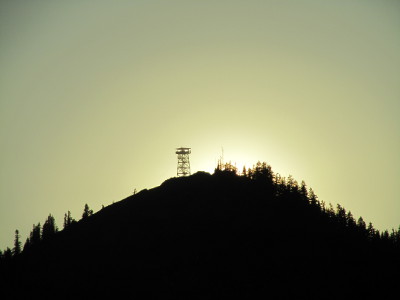
An eagle
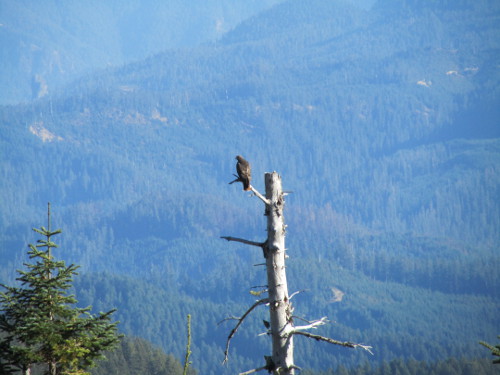
We're at a large gravel spot on the side of the road at about 5,000
feet elevation just short of Bohemia Mountain and the ghost town of
Bohemia City. We enjoy spectacular views, steep hillsides, and remnants
of mining activities from a hundred years ago on the drive up.
Between us we have 60 years of observing experience. Jerry's a bit of a
black box observer, while I'm more of a white box observer. Jerry
saunters opportunistically from object to object while I come prepared
with my list of dark nebulae, having studied them to death ahead of
time.
Per Jerry's black box style, we start with the M13, NGC6207, IC4617
grouping. IC4617 is surprisingly easy, auguring for a spectacular night
ahead of us. Jerry wants to see the planetary nebula Pease 1 in the
globular cluster M15, so we head over to take a look. The planetary
looks like a distinct non-stellar green blob. Since we are looking at
grand globular clusters, I suggested the under appreciated M55 just off
the southern horizon. Next to it is the faint but resolvable Arp 2
globular.
Jerry then aims at Hoag's Object, a ring galaxy. We could see the ring
about 20% of the time with an eyepiece yielding a 4mm exit pupil. Later
in researching the galaxy post-observation, I was surprised to read
that this is object is considered quite difficult with much larger
aperture telescopes. Our observation supports the idea that
transparency or clarity of the night matters more than aperture.
 Compare to a Hubble Space Telescope image
Compare to a Hubble Space Telescope image 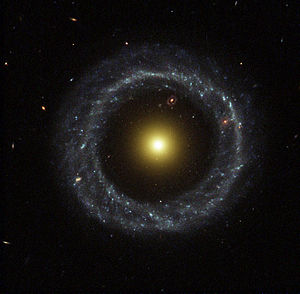
We checked out the pink Garnet Star that serves as a pointer to the IC
1396 area. It is very bright in a large scope; some defocusing helps
with the dazzling light.
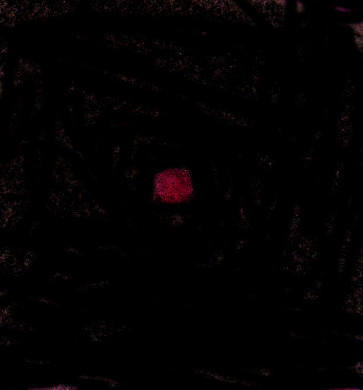
It is time to go white box and dive into my list of 11 dark nebulae:
Barnards 151, 153, 154, 157, 165, 166, 167, 360, 364, 367 and Vdb 142 -
the Elephant's Trunk. I've sketched about 170 dark nebulae so this list
was not exactly show stopper quality, but there was one highlight, the
Elephant's Trunk. We spent quite a bit of time, observing with
different powers and deep sky filters, increasing our ability to see
the trunk. We concluded that the object is best see at 4mm exit pupil
with an OIII filter, though a nebula filter also helps. As we took
turns observing we saw more and more of the object until at least in my
mind, I found it to be an exquisitely subtle and beautiful object with
the dusky curved boundaries. The whole area, IC 1396, is worth several
nights of observing. All of the dark nebulae on my list were in the
immediate area. Though it took time, we managed to track them all down,
identify them, and describe their shapes and opacity. It may seem at
first blush that dark nebulae are not very interesting, but that's not
the case. A hundred years ago astronomers hotly debated whether they
were empty regions between stars or some sort of obscuring clouds.
Today we know that they are clouds of dust. Along with the dark dust
come all sorts of interesting Milky Way objects including globular and
open clusters and emission nebulae. I find the views compelling. For
example, think of the HorseHead Nebula.
For more see my sketches of dark nebulae here.
Finder chart for IC1396, from an image capture of Sky Safari Pro running on a Nexus 7 Android tablet

The Elephant's Trunk, 20 inch at 4mm exit pupil with OIII filter
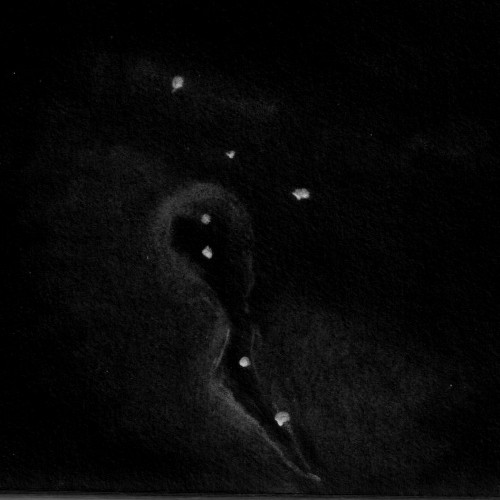
When I can see the Milky Way painted on the dome of the night sky, I
know it is a good night. When the Milky Way billows out like clouds
then it is a superb night. Tonight the Milky Way billows with great
contrast at the edges. The Gegenshein, backscattering light from solar
system's dust, is nicely visible as a several degree glow just to the
east-northeast of Capricornus. Jerry used Sky Safari on his iPad to
calculate the exact anti-solar point, commanding Sky Safari to point
there. Exactly where we saw it in the sky! Later as the night turned to
early morning hours, we could trace the Zodiacal Light from the eastern
horizon rising at a slant, reaching out and touching the Gegenshein; a
sign of near perfect observing conditions. Two-thirds of a state away
we could see the light dome of Portland as a two degree smudge of light
peeking above the perfect northern horizon - amazing. The light glow of
Eugene and the Willamette Valley was hidden behind Fairview Peak to the
northwest. Consequently the dark sky and stars stretched from horizon
to horizon, giving us a sensation of traveling on spaceship Earth.
Gegenshein to the northeast (left) of Capricornus with the Milky Way to the northwest (right)
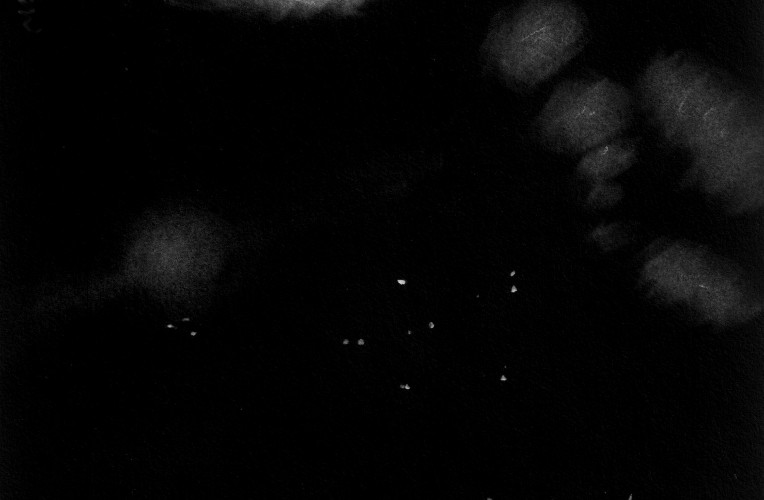
We jumped into Galaxy Cluster land, visiting the Perseus Cluster of
Galaxies (Abell 426) located 250 million light years distant. This
cluster is part of the Perseus-Pisces super cluster of galaxies which
consist of thousands of galaxies. Anchored by the monstrous NGC 1275
and 1273, many dozens of galaxies glowed faintly in the eyepiece. We
traced the cluster's arms for several fields of view. The cluster
betrays the dark matter that it is embedded in, shaped by the baryonic
oscillation that occurred 380,000 years into the Universe's start when
photons suddenly were able to travel with little interaction as
electrons and protons formed neutral hydrogen atoms. This release of
photons caused baryons or matter to suddenly compress generating the
equivalent of acoustical waves in the early Universe. These waves,
400-500 million light years across now, can be traced by galaxy
clusters like the Perseus-Pisces Super Cluster.
Jerry found another favorite cluster, NGC 7619-7626, the Pegasus I
cluster, also a part of the Perseus-Pisces super cluster, this cluster
located about 180 million light years away. We enjoyed four prominent
galaxies along with fainter ones. NGC 7479 was a nice barred-spiral in
Pegasus that we could see one arm more prominently than the other. We
looked at two edge-on spirals (NGCs 7332 and 7339) in Pegasus that
orbit each other and are at right angles to each other. We also saw
detail in the Sculptor Dwarf Galaxy, just above the southern horizon.
We also checked out the Andromeda galaxy with both dust lanes
especially visible. I busied myself counting stars in the Pleiades with
the unaided-eye. I reached 19, my record being 23. Nebulae filled the
telescope's field of view.
With the occasional screech of the Eagles, we decided to call it a
night at 2:30am, running on adrenalin and excitement, not noticing the
tiredness until we were well down the mountain.
eod

 Compare to a Hubble Space Telescope image
Compare to a Hubble Space Telescope image 



